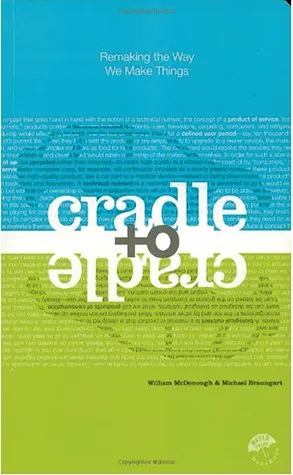Reduce, Reuse, Recycle? Or Remaking the Way We Make Things?
Things are not made to last. In fact, things are made NOT to last. They are meant to break, become outdated, go out of style, or in any case be replaced by newer, more powerful, or more stylish products. The older versions might hang around for a while in the owner's garage, if they are sentimentally attached to them, but eventually they all end up in their final destinations: the ocean or the landfill, along with all the material that went into them. Meanwhile, companies are paying the constantly increasing prices for newly mined raw-material, to make products with increasingly shorter life cycles.

This is nothing unusual. It's how industrial production works, driving the economy. We all know that (if you don't know, now you know). But is all this waste really necessary? The book I want to discuss today suggests no, there could be alternatives. Products could be designed for recycling, making the raw-material in them easily accessible. In fact, products themselves could be made to fill a number of secondary uses, once their primary functions are served. Such revolutionary ideas could come from anyone, but these two authors have the background to be taken seriously for them.
Two Authors Who Know Their Stuff
Dr. Michael Braungart, a chemist and former Greenpeace member from Germany, is founder of the Environmental Protection Encouragement Agency, professor of Process Engineering at the University of Applied Sciences, and Scientific Manager of the Hamburg Environmental Institute. William A. McDonough is an architect from the United States, founder of William McDonough + Partners architectural firm, chairman of the consultancy firm McDonough Advisors, and the first and only individual recipient of the Presidential Award for Sustainable Development. Together McDonough and Braungart founded the McDonough Braungart Design Chemistry, and wrote a number of books on the subject of transforming industrial production to a more sustainable way. Among their clients are such corporate giants as Ford, Nike, The Gap, Herman Miller, and the City of Chicago. The central theme of their projects, organizations, lectures, and books is the same as this title: cradle to cradle productions, instead of cradle to grave.

Consider a Tree...
Just as in Permaculture, the authors use nature as an example to follow. Is there production in nature? - Most certainly there is. Are the products used infinitely? - How could they be? So do they become useless once their life cycle expires? - Not at all!
Imagine a deciduous tree, producing a large quantity of leaves during the sunny part of the year, to do photosynthesis. It all works great until the Fall, when the reduced sunlight makes all these leaves a huge liability for the tree. So it sheds its foliage. Unlike our industrial products, however, they don't become obsolete. Once the tree is done using them, they become important ground cover, provide shelter for numerous species, reduce evaporation of the moisture in the soil, in the winter they reduce the chance of frozen soil, and eventually they are eaten, decomposed, and transformed into humus, freeing up nutrients for the tree, as well as other organisms around it. These are just some of the secondary uses of fallen leaves, but already they seem to eclipse the primary functions. Could this concept be applied to industry?
Less bad is just not good enough!
Another concept discussed in this book is the common approach of industry to reduce the harm products have on us and our environment. Take the emissions of motor vehicles for example: Since we all know that the fumes released by internal combustion engines have harmful effects, regulatory bodies have been making industry reduce these emission further and further, to the point where one car emits a mere fraction of what used to be emitted by one car decades ago. Still, the emission of motor vehicles is harmful. And given the increase in the number of cars world-wide, what is seemingly good news, has actually become worse overall. So why not manufacture products that do not give off harmful substances at all?
The book itself as an example of a redesigned product
Those who read Cradle to Cradle in an actual book format, as opposed to the recently popular electronic one, remember the funny “paper” it was printed on. A type of plastic polymer was used for this purpose, completely waterproof, and interesting to touch. What's more, once the book has been read, and the primary function fulfilled, it could be returned to the publishing company, where the same pages could be cleared and re-printed, thus becoming the medium for another book. The material they used for it could be recycled many more times in this way. Of course, I have to point out that as nice as this idea may sound, our technology has probably already surpassed this opportunity. With electronic readers, or even apps for the phone, one can store and read a number of books simultaneously, while exchanging them almost endlessly. What's important, however, is the idea itself. Whatever works for books should work for other items as well.
A Third Alternative
What struck me as probably the most important message in Cradle to Cradle, is the idea that we don't have to pick sides. Industrial production does not have to be poisonous, unethical, or destructive to our environment. On the other side, ecologic sustainability does not necessarily require the reduction of industry. The two can work together, create amazing products for our use, while at the same time offering benefits to the world around us, AND of course be more profitable in the end. They just need to be properly designed. This is mainly the reason why I consider Cradle to Cradle an important Permaculture book.
Join LBRY To Get Your Own Copies!
If you are interested in reading these books, you can find them on my sustainability channel at LBRY. If you are interested in joining LBRY, please follow my invite. You may also be interested in my other book reviews in my Bibliophilia series:
My 12 Most Recommendable Permaculture Readings
Another 12 Permaculture Books - Specialized Readings
Riane Eisler – The Chalice and the Blade
William McDonough and Michael Braungart - Cradle to Cradle
Charles Eisenstein - Sacred Economics
Ken Kesey - One Flew Over the Cuckoo's Nest
Charles C. Mann - 1491
Tom Wolfe - From Bauhaus to Our House
Ideas and Concepts of Daniel Quinn
B. Traven - The Death Ship and The Cotton Pickers
Books by Wladimir Kaminer
Remembering the Good Doctor Gonzo - Hunter S. Thompson
Tom Wolfe - The Electric Kool-Aid Acid Test
Robert A. Wilson Expanding His Readers' Minds
Gary Jennings' Head-dive into Mexican History